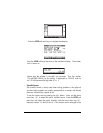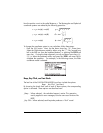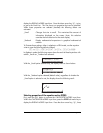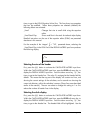
Page 1-24
key. If using the latter approach, use up and down arrow keys,— ˜,
to select the preferred mode, and press the !!@@OK#@ soft menu key to
complete the operation. For example, in the following screen, the Radians
mode is selected:
Coordinate System
The coordinate system selection affects the way vectors and complex numbers
are displayed and entered. To learn more about complex numbers and vectors,
see Chapters 4 and 9, respectively.
Two- and three-dimensional vector components and complex numbers can be
represented in any of 3 coordinate systems: The Cartesian (2 dimensional) or
Rectangular (3 dimensional), Cylindrical (3 dimensional) or Polar (2
dimensional), and Spherical (only 3 dimensional). In a Cartesian or
Rectangular coordinate system a point P will have three linear coordinates
(x,y,z) measured from the origin along each of three mutually perpendicular
axes (in 2 d mode, z is assumed to be 0). In a Cylindrical or Polar coordinate
system the coordinates of a point are given by (r,
θ,z), where r is a radial
distance measured from the origin on the xy plane,
θ is the angle that the radial
distance r forms with the positive x axis -- measured as positive in a
counterclockwise direction --, and z is the same as the z coordinate in a
Cartesian system (in 2 d mode, z is assumed to be 0). The Rectangular and
Polar systems are related by the following quantities:
In a Spherical coordinate system the coordinates of a point are given by (
ρ,θ,φ)
where
ρ is a radial distance measured from the origin of a Cartesian system, θ
is an angle representing the angle formed by the projection of the linear
distance
ρ onto the xy axis (same as
θ
in Polar coordinates), and
φ
is the angle
22
)cos( yxrrx +=⋅=
θ
⎟
⎠
⎞
⎜
⎝
⎛
=⋅=
−
x
y
ry
1
tan)sin(
θθ
zz =


















